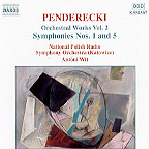Penderecki’s Symphony no. 5 is a significant advance over No. 3, which was presented in Vol. 1 of Naxos’ series devoted to the composer’s orchestral music. Here Penderecki has crystallized and refined his mature style. The Fifth is in one movement, yet commands attention throughout, its highly contrasted sections generating the excitement of watching a great work unfold. The dark introduction utilizes repeated notes to such a degree that it calls to mind the works of Giacinto Scelsi. An aggressive, high-intensity fugue that could have come from a Shostakovich string quartet follows. In fact, the spirit of Shostakovich informs much of this work, especially in the trio of the scherzo, where the orchestration and caustic waltz parody pay homage to the great Russian master. Shadows of Lutoslawski hover over the mighty extended climax that storms near the end of the work. But in truth, Penderecki has created his own musical language, accomplishing his goal of combining the traditional with the new, similar to what Mahler did in his time.
The Symphony No.1 is from the end of Penderecki’s earlier avant-garde period (1973). As such it features many of the experimental compositional devices that made him famous. What sounds like seven loud slaps (a flogging?) begin the first movement. Other curious percussion sounds join in to be followed by rapidly plucked strings and later the full orchestra. Penderecki creates an endless stream of novel and captivating orchestral effects, many of which have been imitated by other composers. In the fourth movement, for example, we hear the squealing woodwinds, tuba blasts, and yelping horns that would later be found in the scores of, for example, John Corigliano (especially his soundtrack to Altered States). Whether this type of music has staying power over time is hard to say, but there’s no denying it makes a powerful initial impact.
Antoni Wit once again has carefully prepared and masterfully performed his teacher’s challenging music, and the Polish Radio National Symphony is behind him 100 percent in every bar. Naxos’ sound is beautifully clear, full, and dynamic. At this price, don’t give it a second thought. Buy it.
[Editor’s Note: Volume Three of this series will contain the composer’s Second and Fourth Symphonies; Volume Four contains the two Violin Concertos.]
































